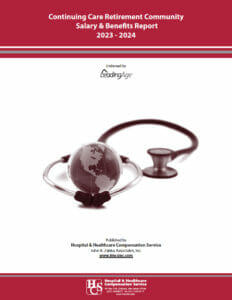

Employees at continuing care retirement communities once again enjoyed healthy salary increases, but the fury of their rise tapered in 2023.
At the same time, the rise of turnover started to slow, another good sign for operators of CCRCs, or life plan communities.
Nursing titles enjoyed the highest average annual pay increases — all above 4.1% — among highlighted job classes in the overall 26th annual CCRC Salary & Benefits Report, which was released by the Hospital and Health Compensation Service Monday.
Certified nurse aides (4.6%), licensed practical nurses (4.1%) and registered nurses (4.0%) led the pace of raises over top level executives (3.8%) and management (3.7%).
When comparing the same facilities participating from a year earlier, however, top execs made up ground. Executive directors rose an average of 4.2%, to $196,666, and chief financial officers were nearly identical, with a 4.3% rise to $177,522.
On the increasingly challenged skilled nursing side of the CCRC equation, nursing home administrators rose 3.2%, to an annual $131,554, and directors of nurses leaped 4.5%, to $112,603. MDS coordinators (RN) saw the biggest skilled nursing rise (5.99%, to $82,367).
Among the senior living ranks, the assisted living/personal care manager rose just 3.0%, to $84,460, while director of resident services/independent living rose 3.7% to $80,605.
“The data shows that while jobs are still seeing large wage increases, the increases are getting smaller,” said Rosanne Zabka, director of reports for HCS, in an email to McKnight’s. “And while turnover rates continue to increase, the rates are only increasing by 1% or 2% now and are not spiking up dramatically as they have previously. It seems all the positive steps CCRCs have been taking to attract new employees and stabilize their existing workforce are working.”
The largest salary survey of its kind, the 2023-2024 CCRC Salary & Benefits Report is published in cooperation with LeadingAge and includes feedback from for-profit and nonprofit operators. It includes data from 477 CCRC/life plan communities, covering nearly 79,000 employees, 13,000 more than last year, Zabka said. Responses cover 46 management and 54 non-management positions.
The 265-page report is available for purchase and includes data on hot topics such as turnover, vacancy rates, sign-on bonuses and more, broken down into national and nine regional averages. Information on salary and hourly pay, as well as 19 fringe benefits, is included.
Bonuses, vacancies impress
Some of the most eye-opening findings came in this year’s newly included categories, sign-on bonuses and vacancy rates, said one compensation expert.
“What really jumped out at me was the sign-on bonuses,” noted Matt Leach, principal and senior consultant for Total Compensation Solutions LLC. “For RNs, more than half of the organizations are offering sign-on bonuses, and the three ‘big’ — RNs, LPNs and CNAs — are all over 50%.”
In actual terms, that equals an average bonus of $4,578 for RNs, “a pretty big chunk of change,” Leach said. LPNs ($3,353) and CNAs ($2,247) also saw hefty average sign-on bonus rises.
Directors of nursing (RNs) had the highest average, with more than 30% of respondents offering a bonus, averaging $7,423. On the other end of the pay scale, at least one-fourth of all respondents offered sign-on bonuses of at least $1,100 to certified medication technicians, dining staff, kitchen staff, dietary aides and housekeeping/laundry employees.
“When organizations are hard-pressed on the money side and they’re offering this amount of money to potential employees, that jumps out at me,” Leach said. “There aren’t enough people in some of these organizations to do these jobs.”
That would not surprise anyone familiar with the business. But even though employee turnover rates have moderated, vacancy rates still stood out to Leach. RNs (19.8%), LPNs (17.4%) and CNAs (17.3%) had the highest rates, but it was the top management’s number that really caught his attention.
“Top-level or senior executives might be a little lower,” he said of job-vacancy rates. “But we’re still talking 13.5% and that’s really high for management. For all levels of management across the board, we’re seeing so many retirements and so much turnover.”
Leach said that while average pay raises “were not astronomical,” they’re still outpacing all-industry norms and are worrisome.
“These increases are not sustainable,” he said. He quickly added that “at least in theory,” CCRCs are in the best position among senior care and living operators to deal with rising labor costs because they can raise resident fees.
Another “silver lining” for governing boards and other operating heads dealing with labor pay is that “you’d be hard-pressed to find anybody who hasn’t heard about how much salaries are increasing.” Inflation and staff shortages are the two biggest influencers, especially for lower level employees, he explained.
Serving up the highest turnover
“It’s a numbers game. If CNAs aren’t able to afford their bills, they’re forced to look elsewhere,” Leach said. “You have to be competitive [as an operator offering compensation]. That’s what these numbers are saying. If you’re not being competitive, there are other organizations that have open slots that will be competitive and poach your talent.”
The annual turnover rate for all CCRC employees was 43.8%, led by dining services (52%), CNAs (48.6%), RNs (42.5%) and LPNs (39.7%). Top-level execs had the lowest turnover rate at 19.3%.
Among same-participating facilities from 2022 to 2023, nurses also fared well, with CNAs given the highest average raise among hourly employees. Nursing facility CNAs rose an eye-popping 9.44% (to $18.96 per hour), while LPNs leaped 5.92% (to $29.78). Staff nurses (RNs), meanwhile, rose 5.75% — down from a 7.7% raise a year earlier — to $37.88 per hour.
On the assisted living side, CNAs also had a huge jump (7.8%, to $18.55 per hour), while resident assistants rose 7.4% to $16.22.
By comparison, therapy titles experienced some of the most modest pay raises among hourly employees. Speech language pathologists went up 3.1% (to $51.07), while physical therapists (3.6%, to $48.97) and occupational therapists (3.7%, to $47.21) had slightly bigger bumps.




